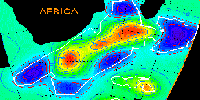

The Magsat magnetic anomalies over the Southwest Indian Ocean are modeled using a combination of induced plus viscous remanent magnetization (IM/VM) and natural remanent magnetization (NRM). Two broad, roughly parallel,SW to NE trending triple-peaked positive anomalies dominate the region, one lying south of Africa and the other north of Antarctica. Although these anonaly peaks generally correspond with the Agulhas Plateau/Maaud Rise, Mozambique Plateau/Astrid Ridge, and Madagascar Ridge/Conrad Rise conjugate pairs, the IM/VRM contribution from sructural characteristics (i.e., crustal thickness) accounts for only about 20% of the anomaly amplitudes. A spatially variable but observationally constrained NRM contribution in Cretaceous Quiet Zone (KQZ) crust is required to account for the location, shape, and amplitude contrast of these anomalies. Many crustal features in the Southwest Indian Ocean near Antarctica have little geophysical data to constrain their structure but do have tectonic conjugates near Africa for which much more geophysical data are generally available. Using geophysical and geological constraints from one member to model the magnetization structure of its conjugate reproduces the observed Magsat reduced-to-pole anomalies over both structures very well. This suggests that no significant alteration in their magnetization structure has occurred since the features split. Models of these conjugate structures show that IM/VRM reproduces the Magsat anomalies associated with non-KQZ crust but that both IM/VRM and a dominant NRM component are required to explain the anomalies associated with KQZ crust.
Journal of Geophysical Research, Vol. 99, No. B6, Pages 11,923-11,936, June 10, 1994
This work was sponsored by the Geodynamics Program of NASA Headquarters